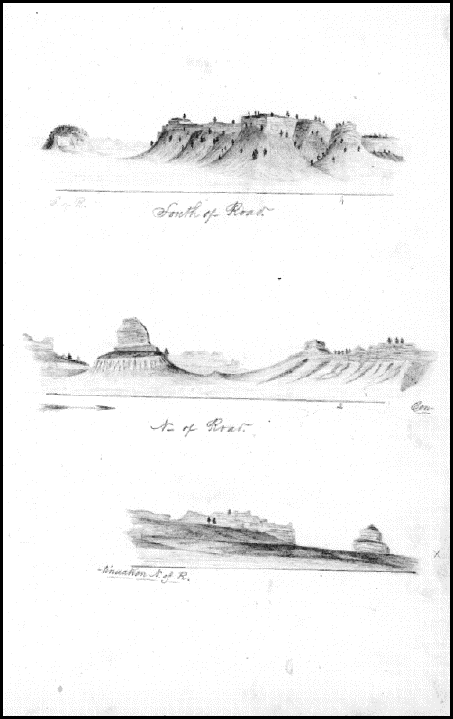William Quesenbury's Overland Sketches 1850 - 1851
David Royce Murphy
(University of Oklahoma Press)

Which was a predecessor to those travelogues you and I used to sleep through at the Fairfax theatre on Saturdays while we were waiting for the main feature, a Tom Mix shoot-'em-up which would keep us glued to our seats --- if the chewing gum didn't do it: all seats at the Fairfax were dotted with Fleers' Dubble-Bubble, spills of Dr. Pepper, leaks of fat from the popcorn boxes and no little smegma).
The Pantoscope was designed to hustle money from locals in the Northeast who didn't care to travel west and get robbed, scalped or beset by bedbugs. J. Wesley Jones's show made it possible for them to stay home in Syosset or Syracuse or Succotash, Va. so the west with all its myriad discomforts could be brought to them, purged of its uglies.
Jones commissioned artists to decorate panels of canvas with bucolic scenes of mountains and valleys and rocks and trees. He set these on rollers in a specially built theatre, complete with elevated platform in the middle. As these sketches of mountains, valleys, rivers and lakes moved by, one could view a panoroma of the western United States without actually having to go about in a dusty cabriolet, while getting eaten by chiggers, frozen by ice storms, sucked on by mosquitoes and shot at by Cherokees and Utes and Arapahos.
William Quesenbury sketched many of these vistas, but after the Pantoscope disappeared, they ended up in people's attics and basements and in college libraries and finally the University of Oklahoma got the wherewithal to collect them together and photograph them and put them out in this glorious oversized volume. It contains almost 200 sketches along with photographs taken from the same locales where Quesenbury made his drawings so one can compare them to his artwork and see how he fudged a little bit here or there to fool the folks in Brooklyn who wouldn't know beans about the Rockies or a be able to tell a butte from a buffalo because they normally don't have buttes or buffalos in Brooklyn (nor, indeed, in Buffalo).
Based on the photographs in this volume side-by-side with the drawings, we now know that William Quesenbury was a fairly mundane artist, with little sense of beauty: his concept of scale is ridiculous, his renderings of actual humans is on the level of my six-year-old grandson. No Leonardo this guy.
What with the gussy-ing up that appears in Scenery, Curiosities, and Stupendous Rocks, his works can almost, but not quite, seem like art, although, as you know some people have it and some don't ... and Quesenbury mostly don't.
If his art was proper and dull, his personal life was all at sixes and sevens. Murphy and the editors try to gloss over it, but Quesenbury was the Tea Party froth-at-the-mouth of his day. He was a loving fan of slaves and slave-holding (he owned two slaves and leased them out to any takers for income). When the Civil War came along, he signed up with the Department of Indian Affairs of the Confederate government, pretending --- because he had made a couple of trips through Indian country of Texas, Utah, Nebraska and New Mexico --- that he was an expert on Indian ways and life. And whenever Quesenbury joined others on a journey west, he always managed to drive his traveling companions up the wall. He claimed they stole his horses, or his pots and pans, or his pants. Once they got into gold country, he said they robbed him of whatever pittance of gold he had managed to extract from the tributaries out near Sutter's Mill.

When he wasn't busy being a drunk or a racist, he was coming up with failing ventures, losing most of his real property and possessions, and regularly irritating the locals. At one point in a journey through Utah, he was told to get a move on, for he so detested Mormons that he strained what little they had in the way of hospitality.
There is a photo of him in the book [see Fig. 1 above]. It is an honest representation of this boozy saloon-crasher, slave-whipper and rabble-rouser. Just look at it and ask yourself: How would you like to spend a month or two going across the windy wild Indian-infested wide-open prairie day and night with a shifty-eyed character like this?
The miracle is that Oklahoma has amassed this fine volume as a tribute to such a scalawag. I mean, if they were to put out a tome devoted to Soutine or Schumann or Sade --- someone who was both mad and a sterling artist, then we'd have something to write home about. But to deliver such a beaut devoted to one who was a star-class bum is something that we can only describe as noble ... as noble an experiment as Prohibition.
We have thus chosen to award our golden five-cluster fig-leaf to the University of Oklahoma Press for making such a sumptuous silk purse out of what could only be described as a crude and ratty sow's ear.